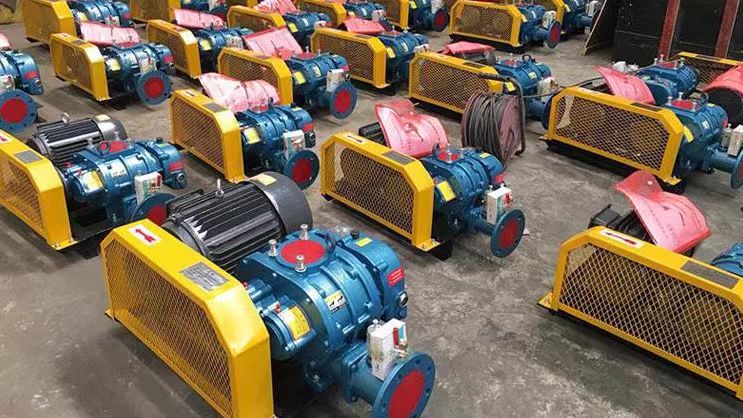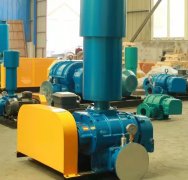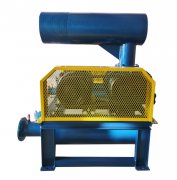Okay, the Roots blower specifically designed for aeration in aquaculture wastewater treatment is a very important and professional application. It is not only the core of the processing system, but also directly related to emission standards, environmental compliance, and the sustainable development of aquaculture farms.
The following is a guide for analyzing and selecting the application.
1、 Core function: Why do we need Roots blowers?
The tail water of aquaculture is rich in pollutants such as nitrogen (N), phosphorus (P), organic matter (COD), suspended solids (SS), etc. Roots blowers play the role of "lungs" in biochemical treatment units such as aeration tanks and biofilters
1. * * Oxygen supply for microorganisms * *: Provides oxygen for aerobic microorganisms (activated sludge or biofilm) to metabolize and degrade organic matter (COD), ammonia nitrogen (NH-N), and nitrite (NO-N) in water.
2. * * Stirring and mixing * *: prevent suspended solids from settling, ensure full contact between tail water, microorganisms, and oxygen, and improve treatment efficiency.
3. * * Promoting nitrification reaction * *: Adequate oxygen is the key to converting toxic ammonia nitrogen into nitrate (NO-N).
2、 Characteristics of aquaculture wastewater treatment and requirements for fans
|Characteristics | Requirements for Roots blower|
| :--- | :--- |
|* * Large fluctuations in water quality * * | Feeding, changing water, and weather can cause drastic changes in water quality and quantity. |The fan needs to have good adjustment capability (frequency conversion control) and be able to flexibly respond to load changes. |
|* * High ammonia nitrogen and high organic matter * * | High pollutant concentration and high oxygen demand. |Adequate and stable air volume must be provided to match the "hard exhaust" characteristics of the Roots blower. |
|* * 24-hour continuous operation * * | Biochemical treatment cannot be stopped. |The fan must be extremely reliable, durable, and able to withstand long-term uninterrupted operation. |
|The environment is humid and may corrode. The air in coastal farms contains salt, while in inland farms, all ammonia corrodes. |The protection level of the motor should be at least IP54 (dustproof, waterproof and splash proof), and the anti-corrosion level should be increased in coastal areas (such as stainless steel fasteners and special paint). |
|Electricity is the main cost, and aeration is the energy consuming unit in the treatment process. |Energy conservation is the core consideration. The combination of frequency converter and Roots blower is the key to energy saving. |
|The operator's professionalism may not be strong. The equipment should be easy to operate and maintain. |
3、 Selection of core parameters calculation
Selection cannot be based on experience, basic calculations must be conducted.
1. * * Calculate the required air volume (Q-m3/min) * *:
*Theoretical Oxygen Demand (OUR): Calculate the total oxygen demand (kgO/d) based on the effluent volume, influent concentration (COD, ammonia nitrogen), and removal target. This is usually done by environmental design units.
*Actual Air Demand: Calculate the total required air volume based on theoretical oxygen demand, selected oxygen utilization efficiency (OTE) of the aerator (usually 15-25 for microporous aeration tubes/discs), water depth, water temperature, etc.
** * Simple estimation * *: For aquaculture wastewater, the empirical value of aeration air-water ratio is usually between * * 1.5:1 and 3:1 * * (i.e. treating 1 cubic meter of water requires 1.5-3 cubic meters of air). But this is only a rough estimate, and it is strongly recommended to conduct detailed calculations.
2. * * Determine the required pressure (P - kPa) * *:
*Pressure=(installation depth of aerator+aerator resistance+pipeline loss) x coefficient (1.05~1.1)**
*Depth (H): The height (in meters) from the aerator to the water surface. **1 meter of water column ≈ 9.8 kPa * *. This is the main part of stress.
4、 Recommended configuration and selection suggestions
|Project | Recommended Configuration | Description|
| :--- | :--- | :--- |
|* * Type of fan * * | * Three leaf Roots blower * * | Mature technology, stable air volume, high cost-effectiveness, and easy maintenance. |
|* * Cooling method * * | * * Air cooling * * | The pressure of aquaculture wastewater treatment is usually ≤ 58.8 kPa (6 meters of water column), with sufficient air cooling and a simple system. |
|* * Control Method * * | * VFD Control * * | * * Required! **According to the feedback of dissolved oxygen (DO) meter, the speed can be automatically adjusted, with energy-saving effect (up to 20-35), and can adapt to changes in water quality. |
|* * Quantity configuration * * | * * Multiple units in parallel * * (such as 2 in use and 1 backup) | Improve system reliability, allowing for emergency start-up of one unit in case of failure. When the wind volume is low, only one is used for higher efficiency. |
|* * Aeration equipment * * | * * Micro porous aeration tube or aeration disc * * | High oxygen utilization rate and good energy-saving effect. Choose products that are resistant to blockage and corrosion. |
|* * Important attachments * * | * Imported muffler, outlet muffler, valve, check valve, elastic joint, pressure gauge * * | Ensure noise reduction and stable operation. |
5、 Installation and maintenance precautions
1. Installation location: The fan room should be well ventilated, rainproof, and moisture-proof. The air intake should be directed to a clean and cool place.
2. * * Pipeline installation * *: The main pipeline needs to be installed with * * brackets * *, and the weight cannot be pressed on the fan. Flexible joints must be used at the connection point.
3. * * Daily Maintenance * *:
*Regularly replace/clean air filters (at least once a month): Blockage is the primary cause of insufficient air flow and high energy consumption.
** * Regular inspection of gear oil * *: Replace after the first 200 hours of operation, and replace every 2000 hours or every six months thereafter.
** * Regular water discharge * *: Regularly check the drainage valves at the air storage tank and pipeline to remove condensed water.
** * Monitoring abnormal noise * *: Pay attention to whether there are any abnormalities in sound and vibration during daily inspections.
summary
The selection of Roots blowers for aquaculture wastewater treatment should follow the following process:
1. * * Calculation Requirements * *: Calculate the required * * air volume * * and * * pressure * * based on water quality and quantity.
2. * * Select the host * *: Based on the air volume and pressure, select the model and power of the three blade Roots blower * *.
3. * * Key configuration * *: * * must be equipped with frequency converters * * and * * multiple parallel * * schemes to achieve energy saving and backup.
4. * * Supporting aeration * *: Selected * * Micro porous aeration system * *.
5. * * Professional installation * *: Ensure correct ventilation and pipeline installation in the fan room.
**Final recommendation * *: Provide your * * tailwater volume and water quality indicators (COD, ammonia nitrogen, etc.) * * to the fan supplier or qualified designers for selection calculation and system design, which is the key to the success of the project. Choose a reputable brand to ensure long-term stable after-sales service and technical support.



